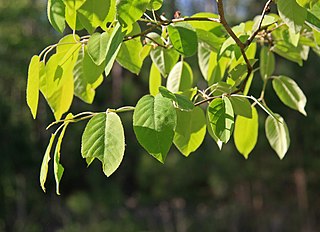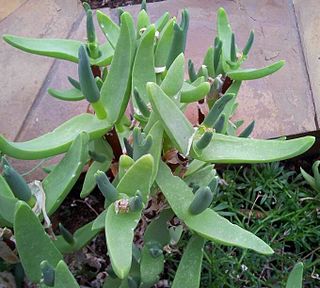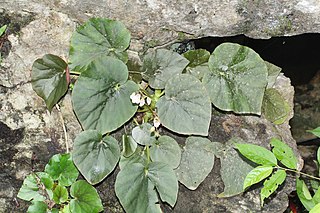
Begonia is a genus of perennial flowering plants in the family Begoniaceae. The genus contains more than 2,000 different plant species. The Begonias are native to moist subtropical and tropical climates. Some species are commonly grown indoors as ornamental houseplants in cooler climates. In cooler climates some species are cultivated outside in summertime for their bright colorful flowers, which have sepals but no petals.

Amelanchier arborea, is native to eastern North America from the Gulf Coast north to Thunder Bay in Ontario and Lake St. John in Quebec, and west to Texas and Minnesota.

Ilex aquifolium, the holly, common holly, English holly, European holly, or occasionally Christmas holly, is a species of flowering plant in the family Aquifoliaceae, native to western and southern Europe, northwest Africa, and southwest Asia. It is regarded as the type species of the genus Ilex, which by association is also called "holly". It is an evergreen tree or shrub found, for example, in shady areas of forests of oak and in beech hedges. In the British Isles it is one of very few native hardwood evergreen trees. It has a great capacity to adapt to different conditions and is a pioneer species that repopulates the margins of forests or clearcuts.

Urtica ferox, commonly known as tree nettle and in Māori: ongaonga, taraonga, taraongaonga, оr okaoka, is a species of nettle endemic to New Zealand. Unlike the other species in the genus Urtica found in New Zealand, all of which are herbaceous, ongaonga is a large woody shrub that can grow to a height of 3 m (9.8 ft), with the base of the stem reaching 12 cm (4.7 in) in thickness. It has large spines that can result in a painful sting that lasts several days.

Begoniaceae is a family of flowering plants with two genera and about 2040 species occurring in the subtropics and tropics of both the New World and Old World. All but one of the species are in the genus Begonia. There have been many recent discoveries of species in the genus Begonia, such as Begonia truncatifolia which is endemic to San Vincente, Palawan. B. truncatifolia is smaller in size than other species of the genus Begonia and this new species is proposed Critically Endangered by standards set by the IUCN. The only other genus in the family, Hillebrandia, is endemic to the Hawaiian Islands and has a single species. Phylogenetic work supports Hillebrandia as the sister taxon to the rest of the family. The genus Symbegonia was reduced to a section of Begonia in 2003, as molecular phylogenies had shown it to be derived from within that genus. Members of the genus Begonia are well-known and popular houseplants.

Hexasepalum teres is a species of flowering plant in the coffee family known by the common names poorjoe and rough buttonweed. This annual plant is native to Mexico, Central America, South America, the West Indies and the United States from California to Florida and from Kansas to Massachusetts. The species is also naturalized in the Netherlands, the Canary Islands, Western Africa, Angola, China, Japan and Korea, India, and Madagascar.

Paeonia broteri is a perennial, herbaceous species of peony. It is an endemic species of the Iberian Peninsula. It bears rose-pink highly fragrant flowers about 12 cm wide and glossy green leaves. It reaches up to 40 centimetres (16 in) in height.

Paeonia clusii is a relatively low (25–50 cm) species of herbaceous peony with scented, white or pink flowers of up to 12 cm in diameter. In the wild, the species can only be found on the islands of Crete and Karpathos, and Rhodes. It has pinkish-purple stem up to 30 cm long and glaucous dissected leaves. P. clusii blooms in mid-spring.
Begonia samhaensis is a species in the family Begoniaceae. Similar to Begonia socotrana but separated by the asymmetrically ovate leaves and the unequal tepals in the male flowers; outer tepals broadly orbicular, 1.5–2.2 × 1.7–2.5 cm; inner obovate elliptic, 1.4–2.0 × 0.8 × 1.4 cm.

Mitrophyllum is a genus of succulent plants of the family Aizoaceae, indigenous to the arid region around the Richtersveld, on the border of South Africa and Namibia.

Begonia cubensis, also known as Cuban holly, is a species of perennial plant that belongs to the Begoniaceae. It is native to Cuba and its habit is an understory shrub. Its habitat range is from moist subtropical to tropical climates.

Begonia palmata is a species of plant in the genus Begonia of the family Begoniaceae. It is a small herb of height 20–90 cm tall. It is found in moist places, next to streams or under the shade. It is found in many parts of Asia, including eastern Himalayas.

Eucalyptus cyclostoma is a species of mallee that is endemic to an area in the south of Western Australia. It has smooth, greyish bark, lance-shaped adult leaves, flower buds in groups of between seven and eleven, white flowers and more or less spherical fruit.

Begonia cucullata, also known as wax begonia and clubed begonia, is a species of the Begoniaceae that is native to South American countries of Argentina, Brazil, Paraguay, and Uruguay. A common garden plant and part of the section Begonia, it was described in 1805 by Carl Ludwig Willdenow (1765–1812). The specific epithet "cucullata" means "resembling a hood" or "hooded".

Begonia elnidoensis is an endemic species of Begonia discovered in El Nido, Palawan, Philippines. The species was compared to Begonia wadei, in that both species have thick-trunked stem, differing in the widely to very widely ovate or subtriangular leaves, with the latter having obliquely ovate leaves, 3-4 secondary leaf veins where the latter has 6 on each side of the midrib, with glabrous petioles compared to latter having puberulous to tomentose, an inflorescence measuring 20–40 cm in length compared to only 6–20 cm, and the differently-sized bracts and capsules.
Begonia balangcodiae is an endemic species of Begonia discovered in Sagubo, Kapangan, Benguet, Philippines. The species was allied to B. esculenta Merr., from which it is distinguished by its cordate leaf base and white tepals, while the latter's leaf base is not cordate and has a vermilion-colored tepals. On the same hand, this species resembles that of B. leucosticta Warburg, differing from the latter on cordate leaf base versus subcordate leaf base, and larger tepals ranging in size from 12 to 18 mm long in pistillate flowers versus the latter's 3–5 mm. Additionally, this species is similar to B. negrosensis Elmer, in that it has lanceolate, glabrous leaf compared to that of latter's obovately oblong and sparsely hairy leaves, and white to greenish tepals, versus that of latter's pinkish tepals.
Begonia gironellae is an endemic species of Begonia discovered in Tanabag, Puerto Princesa, in northern Palawan, Philippines. The species resembled Begonia cleopatrae, in that both species have widely ovate, variegated leaves, and fleshy hairs fused into a ring at the base of the leaf petiole. However, Begonia gironellae differed from B. cleopatrae due to its rosette habit with rhizome shorter to 5 cm long, with very congested internodes, widely triangular stipules, differently-sized lamina and bracts, and capsule with wider abaxial wing. Additionally, B. gironellae is a lowland species occurring in broadleaved seaside forests, while B. cleopatrae grows on hill forest at ca. 400m.
Begonia quinquealata is an endemic species of Begonia discovered in Salakot Falls, Napsan, Puerto Princesa City, in northern Palawan, Philippines. This species, along with B. suborbiculata Merr., are the only two known species in the Philippines with 5-winged capsules. Unlike any other member of Begonia sect. Baryandra, B. quinquealata is very distinctive for being a densely hairy herb with long creeping rhizomes. It differs also from B. suborbiculata in that it has thickly chartaceous, widely ovate leaves that have uniformly green upper leaf surface, densely velutinous, with denticulate leaf margin, outer tepals, and red scabrous ovary and capsules.
Begonia tabonensis is an endemic species of Begonia discovered in Tabon Cave, Lipuun Point, Municipality of Quezo, in Palawan, Philippines. This species resembles B. mindorensis Merr., widely ovate and uniformly green leaves, and inflorescence with sessile glands. However the two species differs on several characteristics: Begonia tabonensis have shorter petioles(10 cm long), smaller leaves(4-8 x 4–6.4 cm); deciduous, chartaceous, glabrous or very sparsely glandular bracts; and slightly pointed, crescent-shaped ovary wing; whereas, B. mindorensis have longer petioles(25 cm long), larger leaves(10-15 x 6-10 cm); persistent, coriaceous, densely glandular bracts; and acute, triangular ovary wing.
Begonia tenuibracteata is an endemic species of Begonia discovered in Salakot Falls, Napsan, Puerto Princesa City, in northern Palawan, Philippines occurring on mossy boulders along road cut in shaded, wet lowland forest. This species, along with B. mindorensis, produces the unusual, conspicuous, persistent bracts on the inflorescences. However, it sharply distinct from the latter due to its ovate to lanceolate bracts, which are hyaline, membranaceous, glabrous or with very sparse sessile glands where the latter have widely to depressed ovate bracts that are coriaceous, densely clothed with sessile glands. Additionally, B. tenuibracteata differs by the congested rhizomes with internodes only to 3 mm long; with shorter petioles ; velvety upper leaf surface; shorter inflorescence ; and fewer stamens (40–50); whereas B. mindorensis have 20 mm long rhizome internodes, petioles 10–25 cm long, glossy upper leaf surface, inflorescence over 35 cm long, and up to ca. 70 stamens














